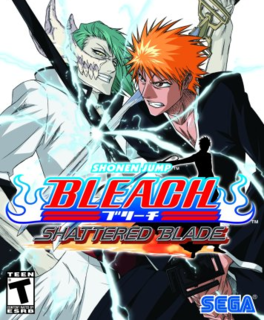Entertaining, true to the anime, and fun to play, Bleach lacks the depth to maintain lasting appeal.
For those not up to speed on the wildly popular Bleach manga and anime, it goes something like this: a violent but good hearted high schooler named Ichigo (written as "First Guardian" in Japanese but sounding like "Strawberry") has always had the ability to see ghosts. One day he happens to something more: a soul reaper or "shinigami" -- a spirit who guides the dead from this world to their eternal rest, and also hunts demons and evil spirits who seek to feed on ghosts and the living alike. Ichigo ends up interfering in a fight between the shinigami and a demon and in the ensuing chaos, ends up being recruited as a temporary soul reaper to help with the demon problem. From there he goes on to meet a wide variety of interesting living, dead, undead and immortal characters who stand on various sides of the conflict between the realms of heaven, earth and hell. In terms of gameplay, what does all of this translate into? Lots and lots of very flashy swordplay, of course.
The game has quite a few playable characters, and allthough I have not spent the time with it to unlock everyone yet, I would say the number is probably about 30 or so. Each character has their own weapon, fighting style, special moves and Bankai powers, all of which look great and unique, but which unfortunately boil down to end up being very similar. Each fighter is equipped with three basic attacks: A vertical slash, a horizantal swipe and a forward thrust. Each of these can also be performed as a more powerful slower version. Each character also has 3 special moves, unique to them which may be melee attacks, charging moves, aerial strikes or projectiles depending on the character. Finally each character has a Bankai meter that charges (very quickly) as you land attacks. Once it full, the player can temporarily enter a charged-up state wherein all of their attacks become flashier and more powerful, and one of their specials becomes ridiculously devastating super move that is often unblockable, undodgable, a near one-hit kill or some combination thereof. These 3 normals, 3 heavy attacks, 3 specials and 1 super move are all that you will have at your disposal in Bleach. There are no ducking or jumping moves, no alternate speed special attacks, no guard cancels, alpha counters, fakeouts or any of the other strategic advancements that have been slowly accumulating in fighting games since Super Street Fighter 2 on the SNES. This means that the fighting is fast, flashy, and easy to learn, but not very technical. The overwhelming strength of the super moves also means that a fight usually boils down to who can succesfully land theirs first, with everything else being irrelevant.
The controls in Bleach are simple and clean. Movement is controlled with the analog thumbstick and attacks are executed with the remote. A horizontal sweep gets you a horizontal attack, moving the pointer from about a 30 degree upward angle to down in a quick motion gives you a vertical strike and thrust of the remote translates to a stabbing attack. Holding the A button while performing these motions gives you a slower, guard shattering version of the attack and holding B will activate a special. The C button on the nunchuck shifts your movement to running and the Z button blocks. The controls are easy to learn but can be overly picky. The horizontal slash for example, requires that you not tilt the controller at all and that you be fairly precise about not moving up or down while you swing. This can be difficult to do during a frenzied match. It is also worth noting that the wide arm movements the game responds best to will require you to be standing and have a fair amount of space around you so you wont smack other players in the face or bang a wall. It also means that you will be standing in front of your TV swinging the remote around and generally looking like a doofus, but that's half the fun of the wii. Super moves are released by shaking the nunchuk vigourously when the bankai bar is full, but this motion will not be sensed if the wii remote moves at all while you are shaking the nunchuck. This can be very frustrating given the power of the bankai moves and the importance of releasing yours as soon as possible.
The visuals in the game are not terribly advanced but do contain alot of flash and make excellent use of shading and motion captured animation to bring much of the visual style of the anime to the screen. Some of the animations that play when a character releases their Bankai charge can be a bit tiresome and lengthy but all are visually impressive. All in all, Bleach is sure to appeal to fans of the series, and fans of the wii who have wondered about the possibilities for fighting games using the wiimote. How long it continues to appeal to you after the inital novelty depends on how deep you like your fighting games. If you'd rather play Super Smash Brothers Melee than Tekken, this game is probably for you. If you wish that SNK would add some more complexity to KoF however, you will quickly grow bored here. Overall 7.8 and definately worth a try if you know someone who has a Japanese Wii.

